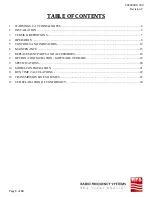
602400011500
Revision C
Page
10
of
24
Ambient air flows through the input air
filter into the air compressor. The
pressurized air is directed to the active
cylinder by the cylinder purge valve. The
active cylinder adsorbs moisture from the
air, and provides a small purge flow of dry
air through the unused cylinder in the
reverse direction. The cylinder purge
valve directs the purge flow through the
exhaust check valve. During and
immediately after active operation the
exhaust flow is audible and represents
normal operation.
The exhaust check valve allows moist air
to be purged from the unit during active
operation while blocking moist ambient
air from reaching the cylinders.
The cylinder check valve isolates the high
pressure
cylinder
dehumidification
process from the low pressure dry air
output section. This check valve also
prevents loss of system pressurized dry
air when the unit is not actively pumping.
When necessary, the unit will switch the
active cylinder to purge the adsorbed
moisture. When this occurs, an audible
rush of pressurized air will exit through
the exhaust check valve in a short period
of time. Air flow at the unit’s output fitting
will be interrupted for a short time until
the newly active cylinder is pressurized
and air starts to flow through the cylinder
check valve.
The safety relief valve is a mechanical
ASME-rated relief valve. If for any reason
the low pressure dry air output section is
over pressurized, then the safety relief
valve will open to prevent an unsafe
pressure condition.
The control board and the humidity and
pressure sensors monitor the low
pressure dry air output and adjust unit
operation accordingly.
The system purge valve allows for
periodic purge and repressurization of
the waveguide or cable system. This
optional feature requires the humidity
alarm option or system purge option to be
installed and configured.
The LOW PRESSURE alarm is standard on
all models. The alarm is set to 0.5psi
below the configured lower operational
pressure
for
standard
pressure
configurations, and a fixed 0.25psig for
low pressure configurations. If the system
pressure drops to the low pressure alarm
threshold, then the LOW PRESSURE front
panel indicator will be lit and the
NC/COM/NO alarm connector pins (pins
1, 2 and 3) will switch states. This alarm
is non-latching and will clear if the
pressure rises above the alarm threshold.
4.3
Choosing
the
Appropriate
Model:
The appropriate model dehydrator should
be chosen based on local power source
and required output flow. Altitude of
installation, desired system lower & upper
operating pressures, and system volume
must be taken into account to ensure
proper application. The run time
calculator in
Section
11
can be used to
help determine the most appropriate
model. RFS Customer Service can help
determine the correct model.
4.4
Available
Options
and
Configurations:
4.4.1
High Pressure Alarm: High pressure can
damage
waveguide
and
pressure
windows. The optional high pressure
alarm can be used as a warning that the
distribution system pressure is too high.
It must be configured at a value of at least
1psi above the configured upper
operational pressure.










































